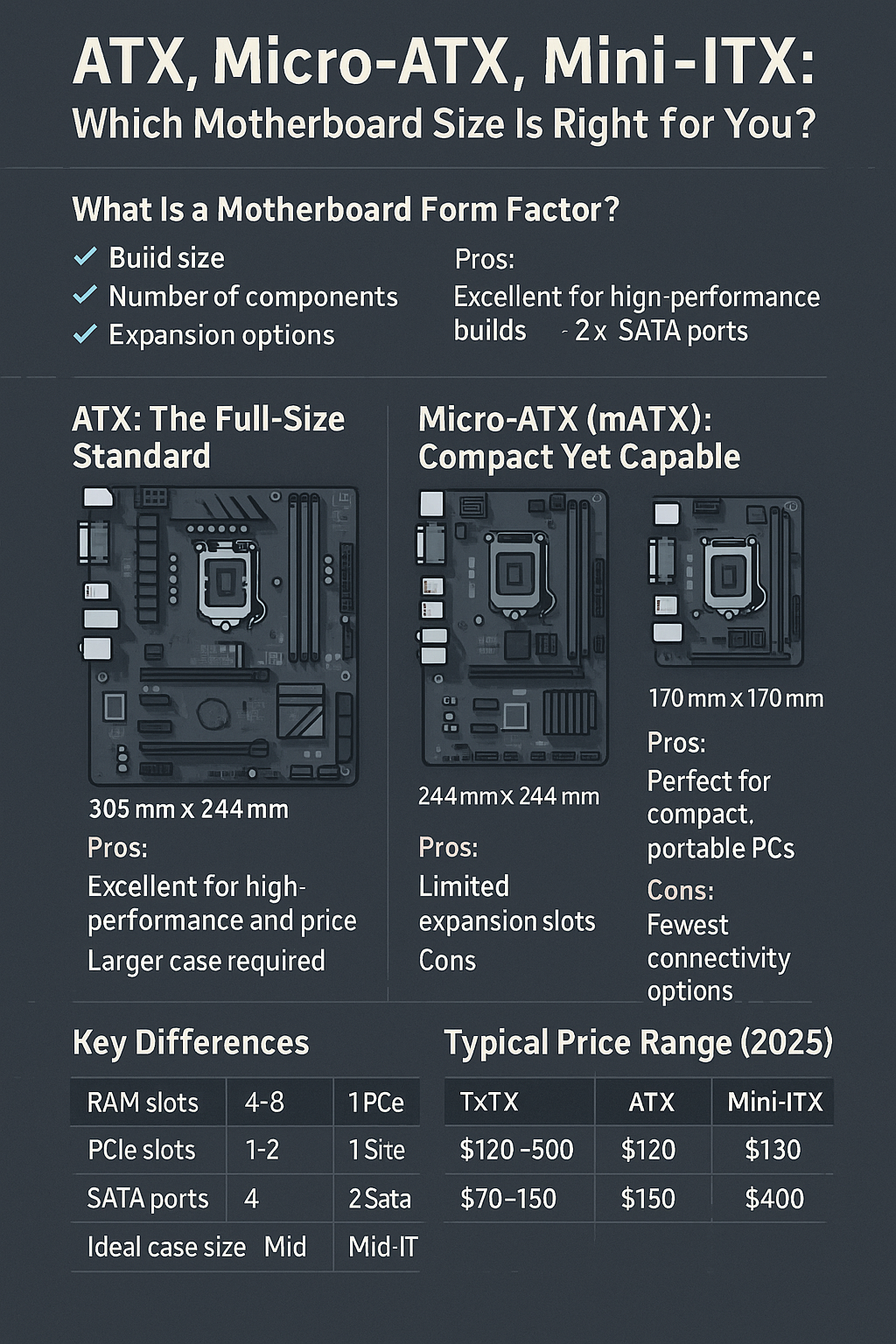Choosing the right motherboard size is one of the most important (and most overlooked) decisions in a PC build. The form factor affects compatibility, upgrade options, airflow, and even the size of your case.
In this guide, we’ll explain the differences between ATX, Micro-ATX, and Mini-ITX, and help you decide which one fits your needs, space, and budget.
1. What Is a Motherboard Form Factor?
The form factor refers to the physical dimensions, layout, and mounting style of a motherboard. It determines:
- The size of the case it fits into
- The number of RAM slots, PCIe lanes, and connectors
- Cooling and airflow compatibility
- Upgrade and expansion flexibility
2. ATX: The Full-Size Standard
Specs:
- Dimensions: 305mm × 244mm (12″ x 9.6″)
- Usually includes:
- 4 RAM slots
- 2–3 PCIe x16 slots
- 6+ SATA ports
- Better VRM cooling and heatsinks
Pros:
✅ Excellent for high-performance builds
✅ Ideal for overclocking and airflow
✅ More ports, headers, and M.2 slots
✅ Easier cable management in mid/full towers
Cons:
❌ Requires a larger case
❌ Slightly more expensive
❌ Not suited for compact setups
✅ Best for: Gamers, streamers, content creators, power users
3. Micro-ATX (mATX): Compact Yet Capable
Specs:
- Dimensions: 244mm × 244mm (9.6″ x 9.6″)
- Typically includes:
- 2–4 RAM slots
- 1 PCIe x16 slot
- Fewer headers/ports than ATX
Pros:
✅ Great balance of size and features
✅ Fits in most cases (ATX and smaller)
✅ More affordable than ATX
✅ Still supports full gaming GPUs and decent airflow
Cons:
❌ Limited PCIe expansion (e.g. no dual GPUs)
❌ May have fewer USB or fan headers
✅ Best for: Budget gamers, everyday users, general-purpose builds
4. Mini-ITX: Ultra-Compact Power
Specs:
- Dimensions: 170mm × 170mm (6.7″ x 6.7″)
- Designed for small form factor (SFF) builds
- Includes:
- 2 RAM slots
- 1 PCIe x16 slot
- Limited ports and headers
Pros:
✅ Perfect for compact, portable PCs
✅ Great for minimalist setups
✅ Can still support high-end CPUs/GPUs
Cons:
❌ More expensive than mATX (despite smaller size)
❌ Limited upgrade options
❌ Often trickier to cool
❌ Requires careful planning and cable management
✅ Best for: HTPCs, LAN rigs, minimalist gaming setups
5. Compatibility Considerations
| Feature | ATX | Micro-ATX | Mini-ITX |
|---|---|---|---|
| RAM slots | 4–8 | 2–4 | 2 |
| PCIe slots | 2–4 | 1–2 | 1 |
| SATA/M.2 storage | 4–8 ports | 2–6 ports | 1–4 ports |
| Rear I/O options | More | Moderate | Limited |
| Cooling support | High | Good | Lower airflow |
| Ideal case size | Mid/Full | Mid/Micro | Mini/SFF |
6. Case Compatibility: What Size Fits Where?
| Case Type | Supports |
|---|---|
| Full Tower | ATX, mATX, Mini-ITX |
| Mid Tower | ATX, mATX, Mini-ITX |
| Micro Tower | mATX, Mini-ITX |
| Mini-ITX Case | Mini-ITX only |
💡 Always check your case’s motherboard support list before purchasing!
7. Cost Comparison
| Form Factor | Typical Price Range (2025) |
|---|---|
| ATX | $120 – $500+ |
| Micro-ATX | $70 – $200 |
| Mini-ITX | $130 – $400+ |
Mini-ITX often costs more due to specialized design and compact engineering.
8. Performance Differences
There is no difference in CPU or GPU performance across form factors — but cooling and VRMs may affect overclocking or stability under load.
ATX boards usually have better power delivery systems for high-end CPUs.
9. Expansion and Future Upgrades
If you plan to:
- Add a capture card
- Install a sound card
- Use multiple M.2 drives or custom cooling
👉 Stick with ATX or a high-end mATX
If you’re building a one-and-done gaming PC with limited expansion needs, Mini-ITX is perfectly fine.
10. Which One Should You Choose?
| If You Want… | Choose This: |
|---|---|
| Maximum expandability | ATX |
| Budget-friendly and compact | mATX |
| Portable or minimalist build | Mini-ITX |
| Best airflow and cable room | ATX |
| Space-saving office setup | mATX or ITX |
Final Thoughts
The form factor you choose will shape your entire build experience. Consider how much space you have, what components you want to install, and how often you plan to upgrade.
Whether you go for a powerhouse ATX or a sleek Mini-ITX build, the key is matching the form factor to your real needs — not just the looks.
